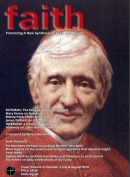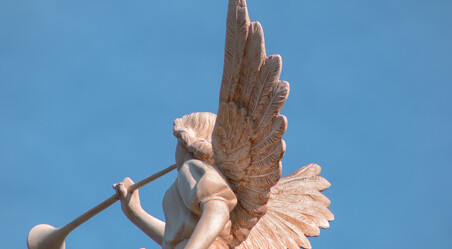"Till You Live In Life So Brilliant"
Tim Weldon FAITH Magazine March-April 2005
“What St. Francis had simply felt and lived, St. Bonaventure was to think….” (Etienne Gilson, The Philosophy of Saint Bonaventure).
A Philosophy of Divine Beauty
In his European Literature and the Latin Middle Ages, author E.R. Curtius writes, “When the Scholastics spoke about beauty they meant by this an attribute of God.”[1] As a representative of Scholastic thought, and with characteristic clarity of insight, Saint Bonaventure’s philosophy of beauty provides support for Curtius’ statement.
Bonaventure’s philosophy of beauty was not articulated in a single body of work as such, but is found rather as a topic in his many sermons, lectures, treatises, and spiritual writings.[2] In these, ever mindful that “the entire world is drenched with the presence of divine mystery,”[3] Bonaventure addressed the recurrent themes in medieval aesthetics, namely symbolism, order and proportion, the metaphysics of light, and most of all, the meditation upon a loving God, “in Him is the highest beauty.”[4]
Bonaventure’s understanding of the beautiful is emblematic of the Franciscan tradition. With his sensitivity to the beauty of created order, the miracle of life and his reverence for the Creator, few figures from the medieval era understood experientially the totality of beauty as much as Saint Francis of Assisi. Indeed, Francis’ profound awareness of the beauty of God’s love for humankind inspired him to found an Order. As Sister Spargo reminds us:
Considering the tradition of Franciscan thought, it is not difficult to understand its preoccupation with beauty and the insistence upon its universality. Who understood more fully the mystical, ecstatic experience than the holy founder of the Franciscan Order, St. Francis of Assisi ? The Order that he founded is thus interested in spreading everywhere the metaphysics of beauty, the poet, artist, lover of nature, gave his genius to his order as part of its patrimony.[5]
A Christocentric Beauty
The Sixth General of the Franciscan Order, Bonaventure’s genius is evident in his cogent insights on the presence of beauty in our lives, insights that begin with, adhere to, and end in the all that is Christ’s loving sacrifice:
Bonaventure sees in Christ marvelously united, the first and the last, the highest and the lowest, the circumferenceand the center, the Alpha and the Omega, the caused and the cause, the Creator and the creature.[6]
Given the aforementioned, it is my contention that Bonaventure’s philosophy of beauty is decidedly Christocentric and culminates in his brief masterpiece, Hymn to the Cross. Herein, Bonaventure’s reflections upon beauty assume the poetic expression of philosophical and theological truths wrought only from a sustained meditation on what is, understood symbolically, most beautiful: The Cross of the crucified Christ.
Metaphysics of Beauty
Bonaventure’s philosophy of beauty is an integral part of, and is to be understood within the whole of his philosophy. In outline, this includes Emanationism, whereby he understands the universe as created by God; Exemplarism, wherein Bonaventure understands God to be the Exemplar of all creation; and Consummation of Reduction, understood as a return or leading back.[7] In Bonaventure’s philosophy, reduction “is concerned with God as the goal of created beings, who illumined by His light, return to Him.”[8]
By analogy, Bonaventure understood beauty to emanate from God as is evidenced in creation, and that, as Creator, God is exemplary beauty. As a reflection of God, beauty then helps lead us back to Him.
In Bonaventure’s scheme, beauty is valued not only for its obvious proportional excellence and brilliancy but more for the heuristic and secondary theophanic value of its symbolism.[9] The experience of beauty at once directs us Godward because it reveals the vestigial presence of the Creator.[10] Beheld, beauty draws the beholder into an enlightened participation in the created world, moving from the esteem for the transience of the material to an understanding of the eternal truths of God’s love.
But enlightenment is not the end of beauty’s symbolic effect nor is it the end of beauty’s influence upon the beholder. Beauty is more than intellectual glean: “It is because Saint Bonaventure clearly saw that beauty leads to love that he was so concerned with the idea.”[11]
Bonaventure valued beauty most for its ancillary quality of transformation: as knowers, once enlightened by the presence of beauty in our lives, we then become lovers, as our actions are informed by and proceed from beauty’s divine exemplarity. “The contemplation of the beautiful transforms one into beauty under the action of love,” writes Spargo.[12]
In the end, beauty leads to love, and love to God. As this movement begins with beauty, an overview of what defines it is in order.
Order and Light
Bonaventure defines beauty as order and light: “Beauty is nothing other than numbered equality or a certain situation of parts, accompanied by a suavity of color.”[13]
It was from the work of Saint Augustine (354-430) that Bonaventure came to understand beauty as order. “Beauty is nothing else than a numbered equality, or unity in plurality,” wrote Augustine.[14] For Augustine and Bonaventure, beauty must exemplify the geometrical regularity of proportion, the ordering of parts that comprise the whole. The ordering of the whole must assume the numerical equality that is foundational to proportion, as beauty cannot exist from proportion and proportion is related to number.[15] Owing to its perfection of order, Bonaventure holds The Trinity to be a model of beauty,
The Blessed Trinity itself becomes the model of all beauty, consisting as it does, of plurality and equality. Here is found a unity of Essence with a Trinity of Persons.[16]
The Trinity is exemplary as numerical order as it precedes and is archetypal for all descending, created order. In God “is found the highest possible harmony of order and the highest possible harmony of nature.”[17] For Bonaventure, this harmony of order and nature must be an illumined harmony.
Influenced by the writings of the Bishop of Lincoln and lifelong friend to the Franciscans, Robert Grosseteste (1175-1253), who combined metaphysical theories of light with the metaphysics of proportion,[18] Bonaventure reasoned that light was primal matter and the source of all form. When generated upon material bodies, light confers form upon those bodies. “Light is the substantial form of all bodies,” he writes.[19] As the source of form, Bonaventure then reasons that light must be the principle of beauty. He explained as much when using the example of sunlight shining through stained glass: color is to be judged beautiful only against its source, light.
In much the same way, Bonaventure understands the beauty of the human person in terms of participation with its luminous source, the light of Christ.[20]
Bonaventure held that the radiating presence of light extended beyond the conferral of form upon matter. True to the symbolism of his aesthetics, he believed light to be divine in source, evident in matter and spirit. As Father Hayes informs us, Bonaventure believed: “There is in the world of creation a corporal light and a created, spiritual light which can be compared in a limited way with God, the divine light.”[21]
It was from creation and the successive order of creation that Bonaventure realized the divinity of light and its quintessentially Christological symbolism. In the first act of creation, God illumined the heavens before all else (Genesis 1:3), while in the greatest act of love He sacrificed His only son and thus delivered the world from darkness. “I am the Light of the world,” declares Christ (John 8:12 ).
As God is the fontal source of light and as Christ is His image (imago expressa Patris), or “similitude” in Bonaventure’s language, the Seraphic Doctor concludes that Christ “is the brightness of eternal light and the spotless Mirror of the majesty of God.”[22] Expounding further, Bonaventure makes it clear that, as corporal and spiritual participants in creation, our enlightenment depends upon participation in Christ’s eternal light, “by their greater or lesser[23] participation in light, bodies acquire the truth and dignity of their being,” writes Bonaventure.[23]
Thus it is in Christ’s declaration from John that we find the defining experience of reductive beauty. As a universal invitation of enlightenment of heart and mind, it is the gift allowing us to follow the truth of Christ’s love. Because of it, our return to God is possible. In the words of Bonaventure: “Through Him all our minds are led back to God, when, through faith, we receive the similitude of the Father into our hearts.”[24]
For Bonaventure, the loving image of Christ on the Cross is the object of our faith, the consummate representation of reductive beauty.
Hymn to The Cross
That an object of beauty is understood to inspire transformation of the beholder is a theme of aesthetic theory in general; that the Cross, as an object of beauty, is understood to inspire even greater transformation is essential to the Franciscan tradition in particular.
The poet Rainer Maria Rilke (1875-1926) provides us with an example of the former. In his well-known poem, The Archaic Torso of Apollo,[25] Rilke ponders the mystery of beauty before the sculpted likeness of Apollo only to conclude that, in the end, exposure to such excellence of form inspires the emulation of or the creation of such beauty in our own lives. “You must change your life,” chides the end line of the poem. Rilke’s message is clear: beauty’s call to the beholder is an ennobling one; it is towards the better that we must aspire.
In the Franciscan tradition, the example of The San Damiano Cross and its explicit message provide a stronger call to change.[26] Known as “The Crucifix that spoke to Francis,” it was at the foot of this Twelfth century Byzantine Cross that a praying Francis was summoned by Christ to repair His house. The response of an inspired Francis was to found an Order, beginning a movement to effect peace, justice and impassioned care for the impoverished and sick. For Franciscans, The San Damiano Cross is the defining symbol of reductive beauty: by calling upon Francis to do His will, Christ brought him, his followers, and the myriads influenced by their example, ever closer to the light of eternal truth.
Bonaventure extends this example of The San Damiano Cross to every Cross and the example of the Francis’ divine summons to everyone.
A Light That Shines In Darkness
In the thirty-nine stanzas (six lines each) that constitute his Hymn to The Cross,[27] Bonaventure incorporates his metaphysics of beauty and the attributes of beauty or the attributes of Christ, into poetic praise.[28] With its allusions to the perfect order that is Christ and of the association of Christ with light, the first two stanzas of the hymn serve as a call to meditate upon The Cross, believe in it absolutely, and commit with impassioned resolve to live in the light that redeemed humanity:
Followers of life’s perfection, May your heart be ever joyful
As you see the Cross divine;
Let the Holy Cross be present
In your soul and meditation:
To its rule your life resign.
Keep it close, with Christ for Leader,
Till you live in light so brilliant
That all doubt is cast away:
Weary not and slacken never,
That your heart be set afire
With a flame as bright as day.[29]
“Love the Cross, creation’s beacon,” is the first line from the very next stanza and the culmination of Bonaventure’s aesthetics: the exemplary beauty that is Christ’s love illumines our way back to God.
In John’s Gospel we are reminded of the enormity of Christ’s love: ”There is no greater love than this: to lay down one’s life for one’s friends.” (John 10:15) For Bonaventure, Christ’s love is perfect love which can only come from perfect virtue. At once the symbol of the greatest virtues and all virtue, The Cross reflects the illumined path of the virtuous:
Cross the mirror of all virtues,
Glorious guide to life eternal….[30]
Conclusion: Light From Light
In conclusion, the perfect love of Christ’s sacrifice enlightened the world to the very virtue that could save it:
Christ is the light of the soul who by his grace awakens the seminal principle of the virtues dormant in it and enables them to bear their fruits.[31]
A kneeling Francis is an example of the awakened soul. In his reflections on beauty and meditation upon The Cross, one imagines Bonaventure conjuring the image of the kneeling Francis before The Cross, awakened by the beauty of Christ’s light, rising from his knees to do God’s bidding which, in the end, is ours as well.
[1] E.R. Curtius, European Literature and the Latin Middle Ages, trans. Willard R. Trask ( London , 1953), 224, n. 20.
[2] If having a philosophy of beauty means composing a single treatise exclusively on the subject as we find in Hegel’s Philosophy of Fine Art, then Bonaventure and his medieval counterparts did not develop a specific aesthetic theory per se. And yet in their philosophical and theological investigations, their commentaries upon beauty, owing to the integration of reason and Revelation, produced deeper insights than aesthetic theories limited to naturalism or the abstract.
[3] Zachary Hayes, O.F.M. in St. Bonaventure, On the Reduction of the Arts to Theology (St. Bonaventure, N.Y.: Franciscan Institute, 1996), trans. Zachary Hayes, O.F.M., p.11.
[4] Sister Emma Jane Marie Spargo, The Category of the Aesthetic in the Philosophy of Saint Bonaventure (St. Bonaventure, N.Y.: Franciscan Institute, 1953) 37, n. 1.
[5] Spargo, .8-9.
[6] St. Bonaventure, The Soul’s Journey into God, The Tree of Life, The Life of St. Francis, trans. Ewert Cousins (New Jersey: Paulist Press, 1978), 18.
[7] Matthew M. DeBenedictis, O.F.M., The Social Though of Saint Bonaventure (Washington, D.C.: Catholic University Press of America, 1946) 18.
[8] Ibid.
[9]“Symbolism is the keynote of St. Bonaventure’s aesthetic.” See Spargo, .xi.
[10]“Saint Bonaventure sees in every created thing a vestige, or footprint of God its Creator.” See Spargo, 51.
[11] Spargo, p.64.
[12] Spargo, 42.
[13] Spargo, 38, n. 3.
[14]] Ibid. See Augustine’s De Musica, VI, 13, 38.
[15] Spargo, 38.
[16] Spargo, 39-40.
[17] Ibid.
[18] Umberto Eco, The Aesthetics of Thomas Aquinas, trans. Hugh Bredin (Cambridge: Harvard University Press, 1988) 109.
[19] Umberto Eco, Art and Beauty in the Middle Ages, trans. Hugh Bredin (New Haven: Yale University Press, 1986) 50, n. .20.
[20] Bonaventure understood color in Christological terms with red being the most beautiful: “Of all the colors, Saint Bonaventure found red to be the most beautiful because this is the color of the Precious Blood of Our Lord.” See Spargo, .61.
[21] Zachary Hayes, O.F.M. in St. Bonaventure, On the Reduction of the Arts to Theology, p.6.
[22] Spargo, 59, cf. St. Saint Bonaventure, De Nativitate B.Virginis Mariae, Sermo II (IX 708-709).
[23] Eco, Art and Beauty in the Middle Ages, 50, n.20.
[24] St. Bonaventure, On the Reduction of the Arts to Theology, 47.
[25] Rainer Maria Rilke, “Archaic Torso of Apollo,” in Mack, Maynard, et al, The Norton Anthology of World Masterpieces, vol. 2 (New York: Norton, 1985) 1654.
[26] For a detailed commentary on the San Damiano Cross, see Father Michael Scanlan, T.O.R., The San Damiano Cross: An Explanation ( Franciscan University Press, 1983).
[27] St. Bonaventure, Hymn to the Cross, trans. Jose de Vinck (St. Anthony’s Guild, 1960).
[28] Allusions to order and light abound throughout the hymn. Order is alluded to as “rule,” (stanza 1) or “perfect” (stanza 11 and16) and “perfection” (stanzas 1, 11, and 16); while light is in mentioned (stanzas 2 and 23) as are its secondary symbols (Christ being the primary symbol of light): “flame” (stanzas 2, 6 and 11), “effulgence” (stanza 16), “fire” (stanzas 2 and 11), and “shining” (stanza 17).
[29] Ibid.
[30] Ibid.
[31] Zachary Hayes, O.F.M. in St. Bonaventure, On the Reduction of the Arts to Theology, 30.





